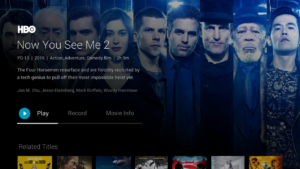Apps Rise and the Box’s Demise: A Peek at Pay TV’s Future
A decade ago, I joined MobiTV as the company was breaking new ground delivering Pay TV services, such as ESPN and ABC News, over mobile devices.While the old school small screen flip phones, and 2G networks didn’t provide the ideal viewing experience, they did usher in the pivotal era of ‘TV Everywhere.’  A decade later, the delivery of Pay TV services on multiple devices is commonplace, and the pace of innovation and change has only accelerated. There is little doubt that even ‘traditional’ TV programming is being increasingly consumed on mobile and in-home retail streaming platforms.Looking back at the unpredictable nature of the last ten years, any effort to forecast the future simply based on current trends is risky at best. After all, in 2007, the viewing experience of Pay TV was very similar to the experience twenty years prior, with the introduction of HD in the 2000s representing one of the only noticeable changes for the end user. Cable companies were facing little to no competition outside of satellite, and innovation was simply not priority.In 2007 the iPhone launched with only a promise of third party app stores. Blockbuster believed in the retail environment, and dismissed the streaming technology challenge of Netflix. Tablets and larger screen mobile devices were nonexistent. The point is that any predictions should be taken lightly. However, looking at the intersection of business, entertainment, and technology, there are some emerging trends that seem like fairly safe bets. The underlying factor is that Pay TV is experiencing a transition to pure IP and open software, much like other industries, from telephony to transportation, have recently done.That said, any predications over the next few years will have to take into account the following:
A decade later, the delivery of Pay TV services on multiple devices is commonplace, and the pace of innovation and change has only accelerated. There is little doubt that even ‘traditional’ TV programming is being increasingly consumed on mobile and in-home retail streaming platforms.Looking back at the unpredictable nature of the last ten years, any effort to forecast the future simply based on current trends is risky at best. After all, in 2007, the viewing experience of Pay TV was very similar to the experience twenty years prior, with the introduction of HD in the 2000s representing one of the only noticeable changes for the end user. Cable companies were facing little to no competition outside of satellite, and innovation was simply not priority.In 2007 the iPhone launched with only a promise of third party app stores. Blockbuster believed in the retail environment, and dismissed the streaming technology challenge of Netflix. Tablets and larger screen mobile devices were nonexistent. The point is that any predictions should be taken lightly. However, looking at the intersection of business, entertainment, and technology, there are some emerging trends that seem like fairly safe bets. The underlying factor is that Pay TV is experiencing a transition to pure IP and open software, much like other industries, from telephony to transportation, have recently done.That said, any predications over the next few years will have to take into account the following:
Speed of networks and access
Perhaps the most impactful change in the next few years will be the commercialization of 5G networks. The leap to 5G will bring far greater speeds and connectivity to homes, assuming the investments are made. The continued improvement will be a game changer by reducing latency and improving quality.Cable companies have become broadband companies and the bundling of video with broadband will be table stakes. The FCC recognizes the importance of 5G as the cornerstone of a national broadband overhaul. Clearly, the need for robust broadband fabric is a prerequisite for next generation of TV viewing.
Rich device ecosystem
Apps have become the way new services are discovered and delivered. This does not happen without powerful play stores and devices that provide increasingly compelling experiences. Clear winners have been established in the mobility sector, putting entire platforms to rest (e.g. Windows Mobile, Blackberry, BREW, etc.). The home is the next battleground for video. Eventually, the lines will be increasingly blurred between location (in-home viewing) and screen size (TV, tablet, phone). The service must be delivered when and where the consumer demands because the money will follow the demand. TV services have the opportunity to leverage millions of dollars of investments in OS platforms, device development, and specialized services (e.g. Alexa, Siri, etc.) to deliver the optimal viewing experience. It is also possible to envision a world where your mobile device is your “Set Top box” that provides you with a completely portable and personalized experience.
Content
Technology and infrastructure are not the biggest wild cards in any future projections. Rather, it is the path of content providers. In ten years, the commercially-created constructs of in-home entertainment, TVE, and OTT will likely be gone. Service providers will not think in terms of a “channel lineup” that consumes a set amount of network capacity. Content will be on-demand and lineups will be fluid. Content providers will need to adapt to new distribution mechanisms and be creative to garner the number of eyeballs required to sustain their business. IP will make it simple to customize an experience for an end user, and make the interchange of content simple for the operator. Just as the cost structure to deliver a Pay TV service today for an operator will become less expensive, so will the creation and distribution of compelling content in an all IP world.What evolves over the next ten years will be driven by a generation that demands a better, faster and cheaper user experience. The changes will not be for the faint of heart.Charlie Nooney is CEO and Chairman at MobiTV.Keep up with Charlie on LinkedIn and Twitter.